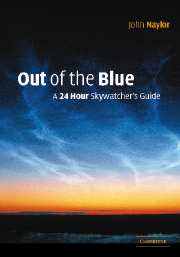Book contents
- Frontmatter
- Contents
- Preface
- Introduction
- 1 Daylight
- 2 Shadows
- 3 Mirages
- 4 Sunset and sunrise
- 5 Rainbows
- 6 Coronae and glories
- 7 Atmospheric halos
- 8 The night sky
- 9 The Moon
- 10 Eclipses
- 11 Planets
- 12 Stars
- 13 Comets and meteors
- APPENDIX: Technical and practical advice for skygazing
- Glossary
- Further reading
- Sources and notes
- Index
- Frontmatter
- Contents
- Preface
- Introduction
- 1 Daylight
- 2 Shadows
- 3 Mirages
- 4 Sunset and sunrise
- 5 Rainbows
- 6 Coronae and glories
- 7 Atmospheric halos
- 8 The night sky
- 9 The Moon
- 10 Eclipses
- 11 Planets
- 12 Stars
- 13 Comets and meteors
- APPENDIX: Technical and practical advice for skygazing
- Glossary
- Further reading
- Sources and notes
- Index
Summary
This book is about things that can be seen in the sky. We all look at the sky from time to time, though usually it is to check the weather. By and large we don't look at it for enjoyment, in part because we don't know what to look for. Very few people who are unfamiliar with the many wonderful sights to be seen in the sky accidentally notice halos or sundogs, two of the most common optical phenomena. To be sure of seeing these and other sights, you must know what to look for and when to look. This is where I hope this book will come in useful. It has been written to help you find your way around the sky, and see for yourself the many wonderful things that it has to offer.
My earliest memory of looking at the sky is of having the three stars that make up Orion's Belt pointed out to me. I can't recall what I made of them; I remember being told that they are distant suns, though that didn't mean much to me at the time. I was, I think, six or seven years old.
It was, nevertheless, a defining moment, the start of a lifelong fascination with the sky.
- Type
- Chapter
- Information
- Out of the BlueA 24-Hour Skywatcher's Guide, pp. xi - xiiPublisher: Cambridge University PressPrint publication year: 2002

